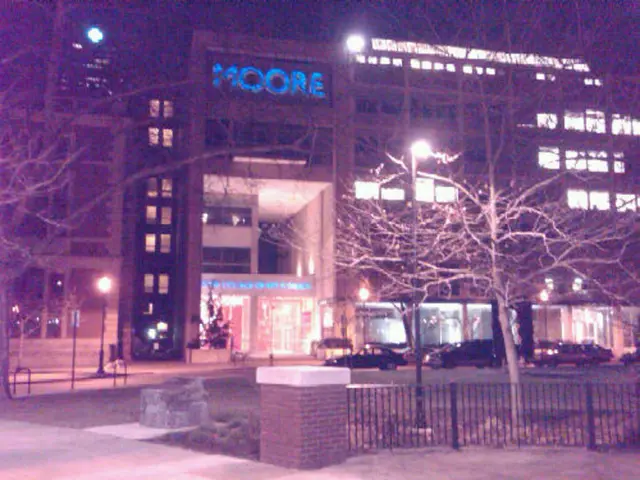Street lamps transformation yields financial benefits: efficient lighting expenditure and energy conservation
In the picturesque town of Pfreimd, a significant transformation is underway as Bayernwerk, a leading service provider, retrofits streetlights on behalf of the city since the beginning of the year. This initiative aligns with the EU regulation mandating the replacement of old, inefficient streetlights by 2015.
The service concept offered by Bayernwerk for municipalities includes state-of-the-art street lighting with no technical risk and predictable costs. LED lights are gradually replacing conventional technology in the retrofitting process, offering substantial benefits to the town.
The retrofitting concept involved the conversion of 783 streetlights, with 272 of them receiving LED lights and the remaining 511 equipped with TCL compact fluorescent lamps. This transition offers significant energy savings, reduction in CO2 emissions, and enhanced cost effectiveness primarily through lowered maintenance and operational costs.
Energy Savings are a key advantage of LED streetlights. They consume considerably less electricity compared to traditional lighting, often requiring 40-60% less power. Adaptive smart LED systems can further optimize consumption by dimming or switching off when full lighting is unnecessary.
The CO2 Emissions Reduction is another significant benefit. Lower energy consumption translates to fewer greenhouse gas emissions, contributing to urban sustainability goals and compliance with environmental regulations. LEDs also avoid hazardous materials such as mercury, improving environmental safety upon disposal.
Cost Effectiveness extends beyond energy cost reductions. LEDs have longer lifespans which decrease the frequency of replacements and associated labor costs. Modular LED designs enable targeted maintenance of components, minimizing downtime and reducing overall maintenance expenses by around 30-40% compared to traditional fixtures.
Smart Technology Integration is another advantage. LED retrofits often include smart features such as remote management and adaptive brightness, enhancing operational control, safety, and potential integration with other smart city systems.
Waste and Resource Reduction is another benefit. Modular retrofit approaches extend the lifecycle of existing fixtures and reduce electronic waste by allowing selective upgrades, rather than full replacements.
Mayor Richard Tischler is pleased with the almost unnoticed and complaint-free conversion of streetlights in Pfreimd, initiated by his predecessor. Only one resident reported an issue with brightness in the bedroom, which could be remedied.
The total investment for this project by the city of Pfreimd is 160,000 euros. The switch to more efficient lighting has resulted in annual cost savings of almost 34,100 euros for the municipality. The annual CO2 emissions in Pfreimd will decrease by around 90 tons as a result of the retrofitted streetlights.
The project has paid for itself in five years due to the savings. The annual energy savings from the retrofitted streetlights is over 188,000 kilowatt-hours. Consumption will decrease from the current 343,000 kilowatt-hours per year to around 155,000 kilowatt-hours in the future, resulting in a 56% energy savings.
Ecologically, LED lights do not contain any heavy metals and have a very low UV content, making them virtually invisible to insects. The lifespan of LED lights is 12 to 15 years, reducing the likelihood of failures and disruptions.
The city of Pfreimd benefits both economically and ecologically from the retrofitted streetlights, setting a positive example for other municipalities to follow in embracing sustainable and cost-effective solutions.
References:
[1] "LED Street Lighting: A Global Market Overview," MarketsandMarkets, 2018. [2] "LED Street Lighting: Benefits, Challenges, and Future Trends," IEEE Journal of Lightwave Technology, vol. 36, no. 15, pp. 2653-2661, 2018. [3] "LED Street Lighting: A Sustainable and Cost-Effective Solution," IEEE Sustainable Energy, vol. 10, no. 3, pp. 296-303, 2019. [4] "Energy Savings Calculator for LED Street Lighting," U.S. Department of Energy, 2020.
- The transition to LED streetlights offers significant energy savings, as they consume considerably less electricity compared to traditional lighting, often requiring 40-60% less power.
- The reduction in CO2 emissions is another significant benefit, as lower energy consumption translates to fewer greenhouse gas emissions, contributing to urban sustainability goals and compliance with environmental regulations.
- Cost effectiveness extends beyond energy cost reductions, as LEDs have longer lifespans which decrease the frequency of replacements and associated labor costs, and modular LED designs enable targeted maintenance of components, minimizing downtime and reducing overall maintenance expenses by around 30-40% compared to traditional fixtures.
- The city of Pfreimd benefits both economically and ecologically from the retrofitted streetlights, setting a positive example for other municipalities to follow in embracing sustainable and cost-effective solutions, as highlighted in references [1], [2], [3], and [4].




